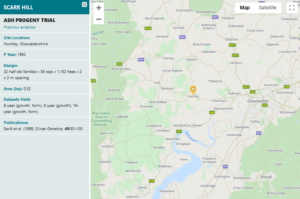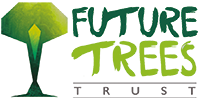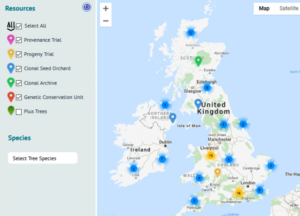by Future Trees Trust Researcher Joe Beesley
In this edition of the Future Trees Trust blog I will be taking you on a tour of a new interactive platform we’ve just finished developing. The UK Forest Genetic Resources (UKFGR) database is a freely available and easy-to-use map of Forest Genetic Resources (FGR) held within the UK. UKFGR contains research trials, seed orchards, Genetic Conservation Units (an outcome of the EUFORGEN programme) and plus trees (superior individuals used in tree improvement). Each resource, be that a trial, woodland or specific tree, is represented as a colour-coded pin on the map. Currently there is a focus on broadleaved species, but we intend to expand the database and include conifer trials and orchards too. By bringing these resources together in one place, we hope to foster collaboration and improve research into the use and preservation of the UK’s unique FGR.
The platform has been developed as a result of the Strategy for UK Forest Genetic Resources which was jointly written by Future Trees Trust, Forest Research, Woodland Trust, UK Centre for Ecology and Hydrology and Royal Botanic Gardens, Kew. It describes a detailed approach for conserving the UK’s diverse trees and shrubs and we hope that the UKFGR platform will become a vital tool for developing and realising the objectives it sets out.
Here, I’m going to show you how the platform works and the information you can find on it. We are encouraging other organisations to include their forest genetic resources and make this database as comprehensive and powerful as possible.
The UKFGR platform can be accessed at www.ukfgr.org and the interactive map selected in the top right-hand corner. The default screen shows a map of the British Isles filled with pins and a legend on the left-hand side.
The legend shows the colour-coded pins for each type of genetic resource and checkboxes to filter them on the map. Below is a drop-down box that can be used to display resources for one particular species. You can reset the checkboxes by clicking the circular arrow in the top right of the legend.
The map itself can be navigated by clicking-and-dragging with the mouse and using the mouse wheel or buttons in the upper left corner to zoom. The basemap can be changed between Map and Satellite with the buttons in the upper right corner. Where many pins are close together, they are clustered, and the number of pins displayed in the circle. By clicking on a cluster, the map will zoom in to show the individual pins.

Details of the ash progeny trial at Scarr Hill
When a pin is selected the legend is replaced with an information box that displays details of that genetic resource. This includes information such as the year of planting, site design and area. If any available datasets have been collected at that site or publications written, these are also listed. Seed orchards that are registered on the National Register of Approved Basic Material have their registration ID included too.

The location listing below the map when filtered for ‘Sweet Chestnut’ and ‘Clonal Seed Orchards’
Finally, below the map is a listing of all the genetic resources filtered by the current selections in the legend. By clicking on the name of a site the corresponding pin on the map will be highlighted and the resource information displayed in the left-hand panel.
UKFGR is in its early stages and we are excited to get other organisations involved. The database is a collaborative and open access repository to facilitate and improve all research involving FGR in the UK. If you would like to contribute resources to this database or access any of datasets listed, then please contact research@futuretrees.org



Leave A Comment